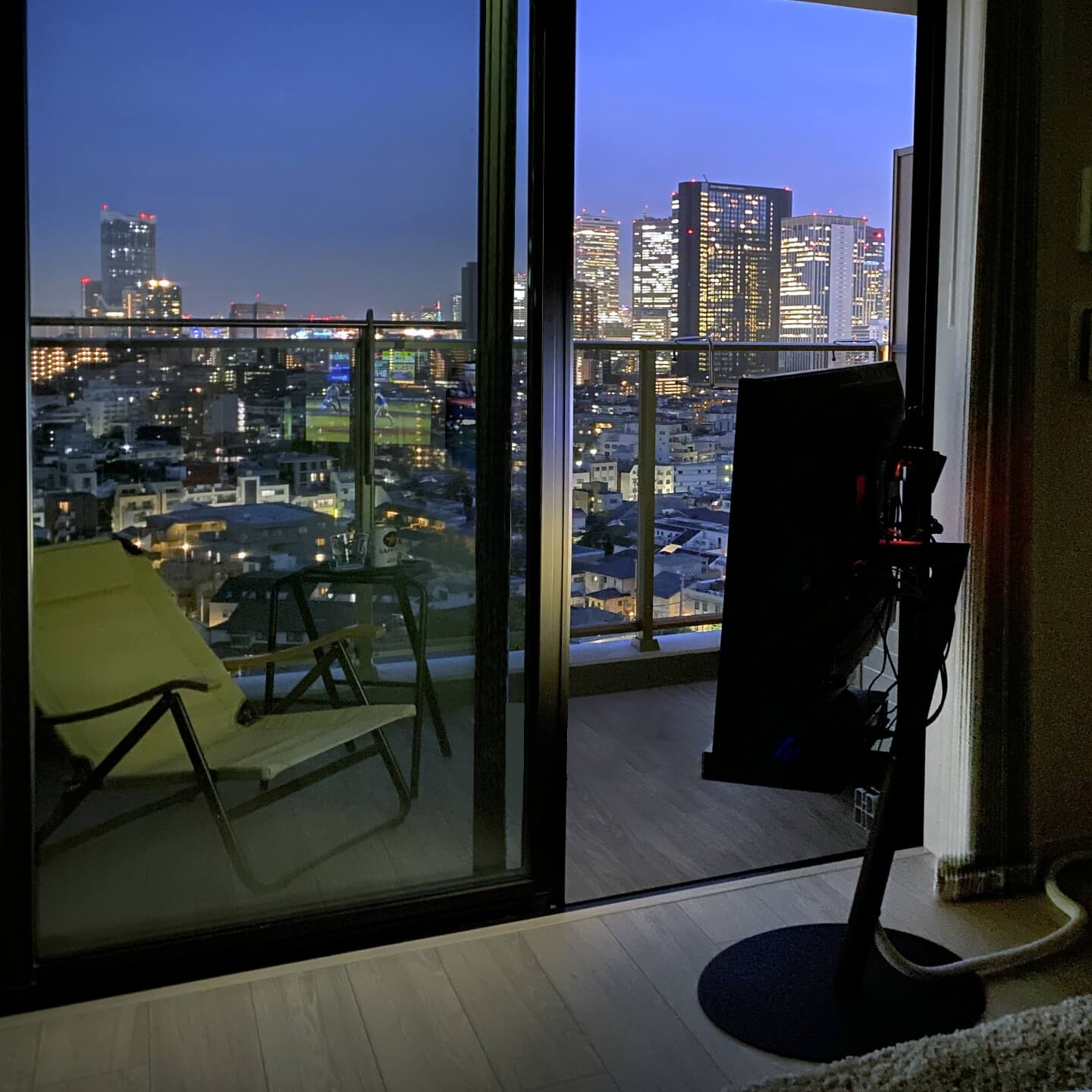
My summer time pleasure is to watch professional baseball night games.
As I dislike an air-conditioned room, I much prefer sitting on the balcony deck chair. It’s my blissful pleasure to cheer my favorite team while exposing myself to night breeze with a cooled beer jug in my hand.
Up until a few years, I was satisfied with just watching the events on my smartphone display, but gradually started to feel incompleteness. I just wanted to watch the matches on a big scree.
At the time, our planning and development team had a series of discurrions day after day on “how should a TV stand be to allow you to put the TV where you want it”. I myself was also curious to find a better viewing environment.

However, you can’t place a TV outdoor on a steady based, nor is it realistic to determine its location inside a room giving top priority to viewing from balcony. An extra TV set dedicated for viewing night matches would easily become redundant on the days when no night game is held.
“Hey, If the TV was movable, it could easily become multi-purpose device, extending the range of fun tremendously”
Isn’t this just the “TV viewing environment with freedom” that our customers are after? This inspiration made me to present an offer for “movable TV” to the company.


My passion seemed to start spreading among my colleagues. More and more of my colleagues started to think in favor of the idea of “private uses” of the TV for a variety of purposes such as playing video games and video streaming. It all seemed to progress smoothly.
My initial idea was simplistic - just adding casters to the base. My superior intervened to reconsider the proposal. Nothing inappropriate for our GOOD DESIGN AWARD winning WALL TV stand would be allowed. The beauty of “WALL” was not to be sacrificed for the sake of “mobility”.
Faced suddlenly with the challenge of preserving stylishness, or identity, of “EQUALS products”, we had to stop temprarily.
Repeated discussions, involving those colleagues who supported the idea, came to a conclusions:
“the casters must be invisible from outside”
“The gap between the base and floor should be as narrow as possible, so that the user does not notice the presence of the casters”
As it was clear that the casters available on the market wouldn’t provide the desired low-height, we didn’t have other option but to develop it in-house. At first a “ball type caster” was considered because of its low profile, but soon it was found that trash and dust can clog it and damage the floor, and also the oil from the bearings would stain the floor. This was defeating the purpose.

After a process of trial and error, the first trial model was made. A new caster prototype with bearings in the rim of a round disk which holds a fixed axis.
The design was uniquely ours, not to be found anywhere else. I got the inspiration form a bike I saw in a science fiction movie. It had the handle on the sides of the wheel, giving it an extremely low profile, and cool futuristic looks.
The design that had kept my fancy ended up helping me in an unusual way.
Having overcome the drawbacks of “ball-type caster”, the project started to progress forward.
By the end of the year and through a lot of brushing up, the prototype was finally taking more realistic shape. All parts except the wheels were made of metal to ensure enough strength.
In addition, our experiments showed that by arranging a number of casters has an effect of reducing “warping of product” and “damage to the floor”.
By this time, I came to realize anew the essence and value of product development: “capability of the product to be used freely without noticing what lies behind”. By the time when the professional baseball spring camp season came to close, the long and tedious caster development reached finally to commercialization phase.

The “final hurdle”, to which the planning and development team watched closely with bated breath, was the antiquake verification test. All WALL products have to pass this test under the most severe and stringent conditions.
As the reader who has read this article to this point would anticipate, The five caster-bearing models successfully met the standards imposed in the antiquake test.

Viewing night games this year provies me with exceptional satisfaction. Placing the large TV near to me on the porch and I can watch the screen in an comfortable posture.
The screen image, much larger than on the smartphone, is so powerful and I can even trace the white ball clearly.
In the bottom of 9th, the camera follows the ball as it slowly rises. Soon I realized it would be the come-from-behing smash.
Wave of joy in the grand stand came to my eyes, and I inadvertently hold up my fists spilling the beer from the glass in my hand.


NAKAMURA Co. Ltd.
Planning and development group
Industrial designer, Takashi Kurita
After finishing engineering graduate school in 2005, Mr. Kurita joined a construction machine manufacturer and engaged in design and development of heavy equipment.
Then he shifted his career to ironwork, where he cultivated metal processing know-how at the forefront.
In 2020, he joined NAKAMURA Co. Ltd. and is currently a member of the WALL TV stands development group.

PRODUCT LINE UPIntroducing the full SEVEN STAND Series lineup
-

SEVEN STAND A2 LOW TYPE
A compact model providing the freedom of placing a TV almost anywhere.
(Supports 24 to 55 inch TVs)$330
-

SEVEN STAND A2 HIGH TYPE
The HIGH TYPE model is an ideal choice for installing monitors (24 to 55 inchs) and other equipment at elevated positions in such spaces as dining facilities and board rooms.
$330
-

SEVEN STAND A2 LARGE TYPE
A simple and modern design (for 45 to 80 inch. TVs) that allows placing a large monitor virtually anywhere.
$360